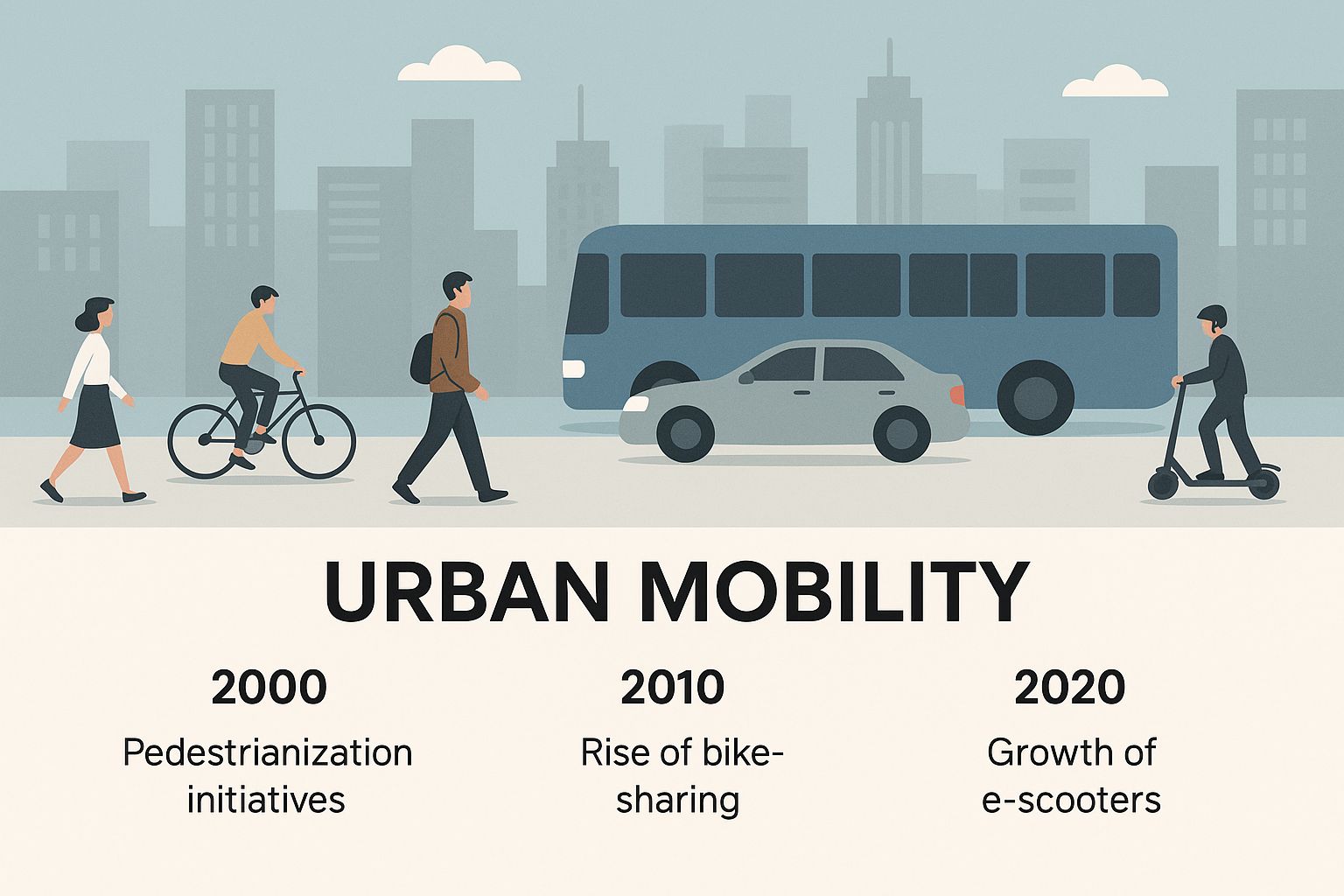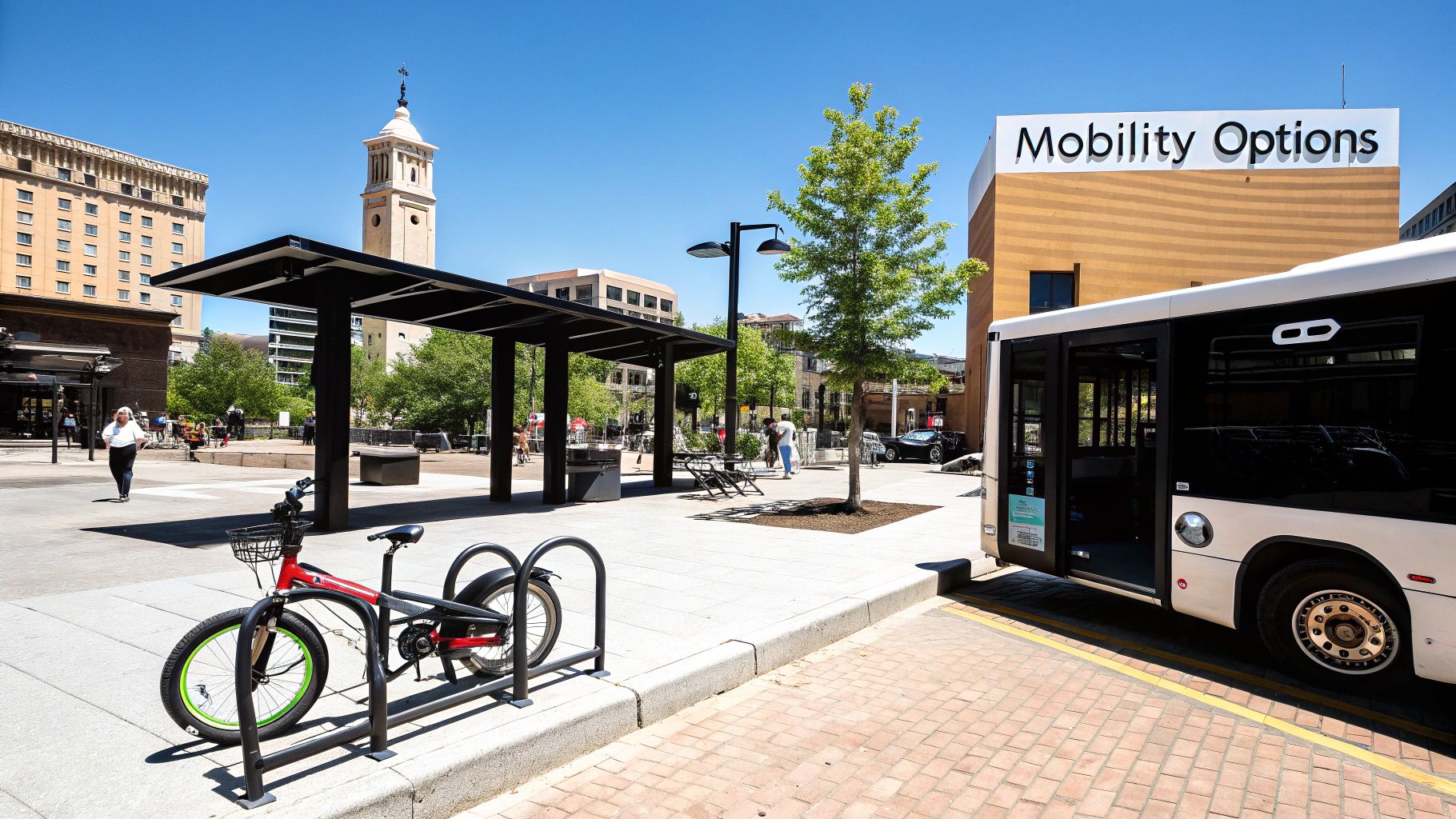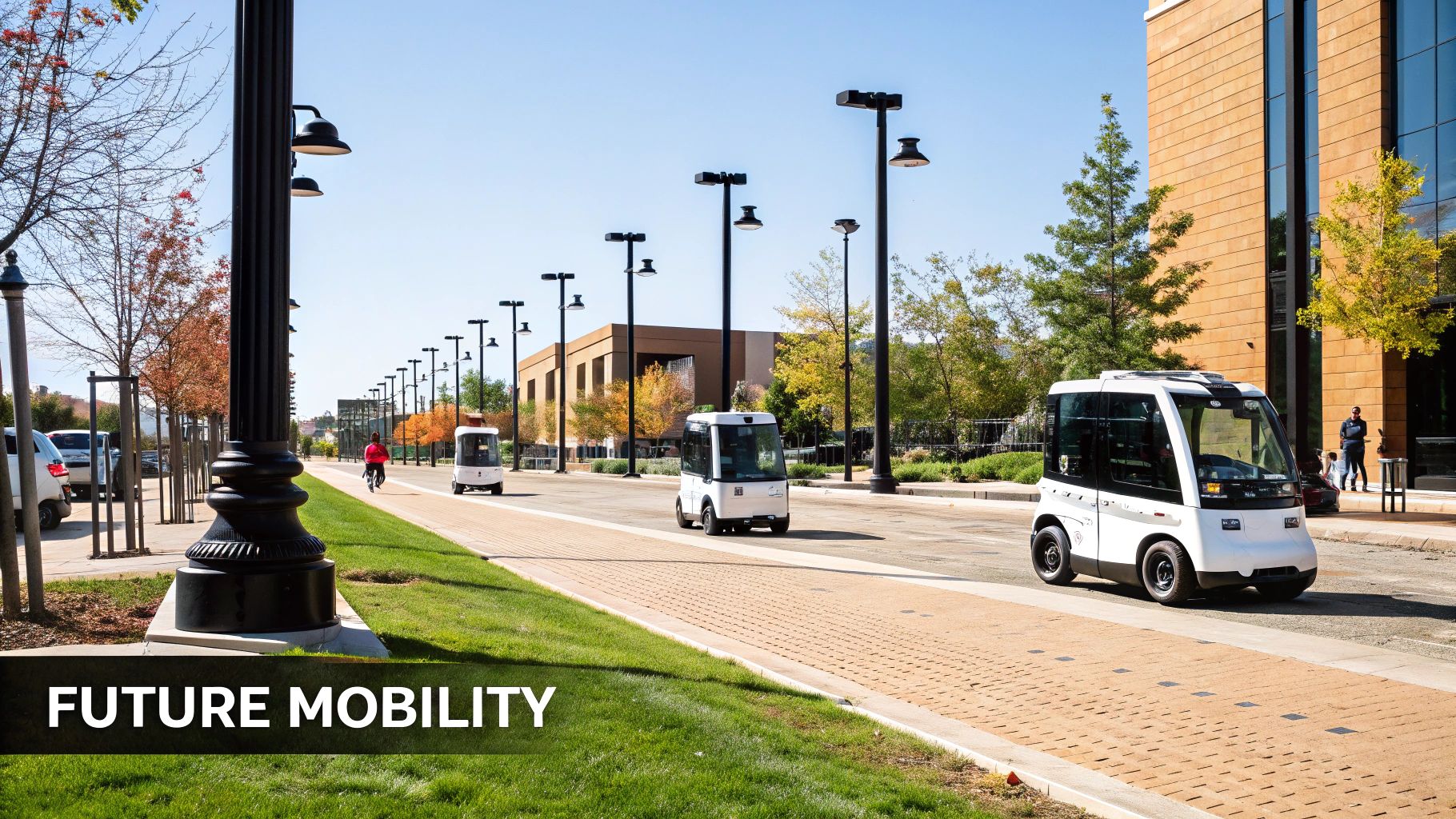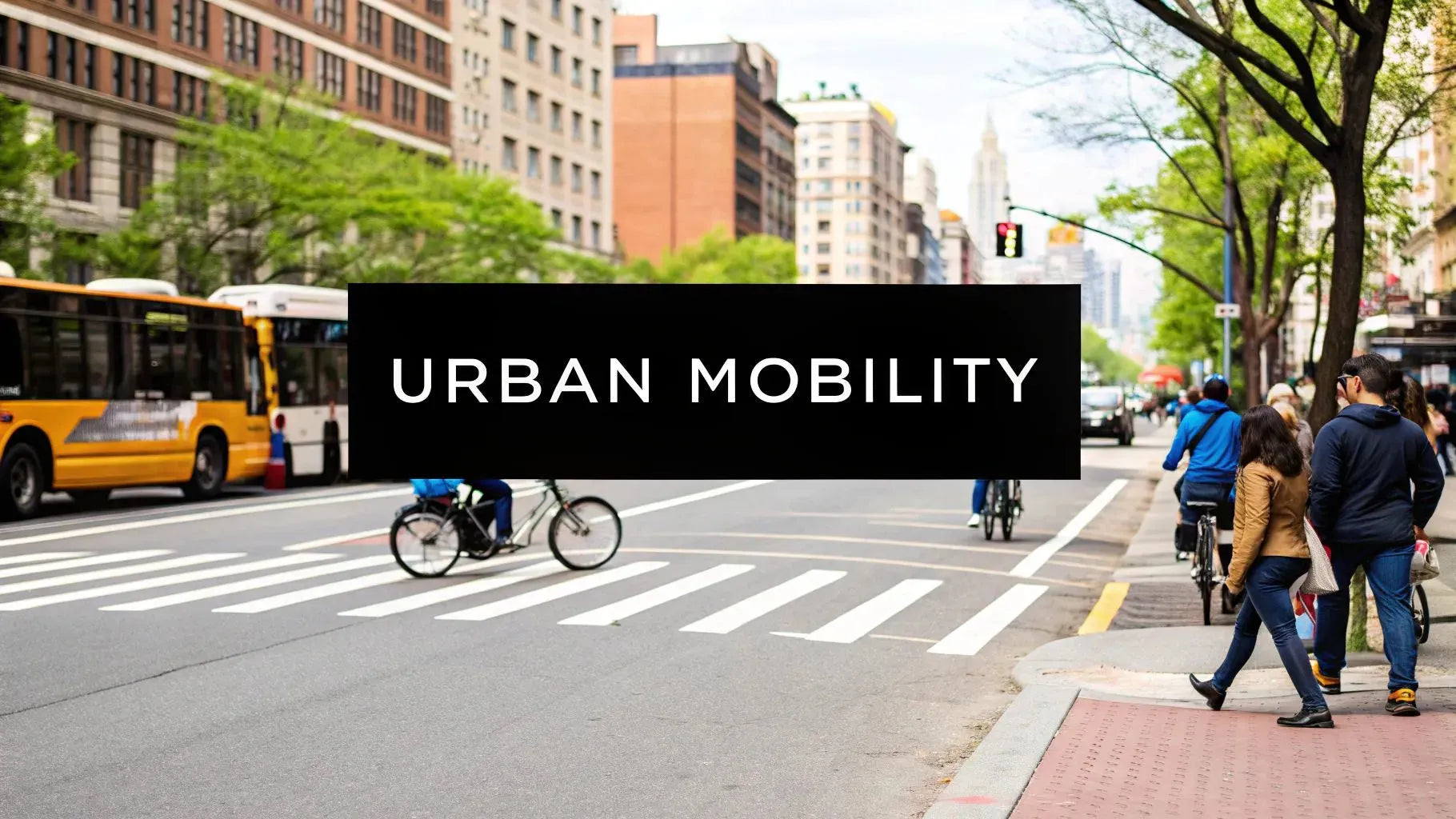Ever feel like getting around your city is a daily puzzle? That's urban mobility in a nutshell. It’s the entire web of ways people and things move through a city. It's not just the bus you catch or the e-scooter you might grab—it’s the whole network of transportation, the infrastructure holding it all together, and the tech making it work.
Unpacking the Meaning of Urban Mobility
Think of your city like a living body. The transportation network is its circulatory system. When it’s working well, everything flows, keeping the city healthy, efficient, and honestly, just a better place to live. Getting from point A to point B is part of it, but the real story is how we make those trips.
For decades, cities were designed around walking and, later, the almighty private car. But that script has been completely flipped. A truly effective modern city offers a rich mix of public transit, cycling, walking, and a whole host of new tech-powered options that are finally breaking our total dependence on personal cars.
This complex ecosystem is built from several key pieces. Let's break them down into the core building blocks you see in most modern cities today.
The Building Blocks of Urban Mobility
| Mobility Type | Examples | What It Solves |
|---|---|---|
| Public Transit | Buses, trains, trams, subways | Moving large numbers of people efficiently over longer distances. It’s the workhorse of the city. |
| Active Mobility | Walking, cycling | Short trips, first/last-mile connections, and improving public health while cutting emissions. |
| Shared Mobility | Bike-sharing, e-scooter rentals, car-sharing | On-demand access to a vehicle without the hassle and cost of owning one. |
| Micromobility | E-scooters, e-bikes | Nailing those short "last-mile" journeys from the train station to your office or home. |
| Private Vehicles | Cars, motorcycles | Still essential for many, but they're now just one piece of a much larger, more integrated system. |
Each of these parts plays a unique role, and when they work together seamlessly, the city’s entire transportation system becomes greater than the sum of its parts.
The infographic below really brings this to life, showing how all these different elements can share the same street.

You can see how pedestrians, cyclists, buses, and scooters aren't just competing for space but are part of a vibrant, interconnected environment when planned correctly.
More Than Just Movement
So, what is urban mobility when you boil it all down? It's really a way of thinking about city planning as a whole. It’s the recognition that how we move affects everything—our economy, our health, and even social fairness.
Just look at the difference in access. In many European cities, a staggering 92% of people live within a 10-minute walk of a public transport stop. That number is way lower in many US cities, and it makes a huge difference in people's daily lives.
Urban mobility isn't just about the vehicles; it's about designing a system that provides freedom, access, and opportunity for every resident, regardless of how they choose to travel.
This focus on accessibility is exactly why cities from Sydney to Vienna are pouring money into creating integrated networks. When you get mobility right, you get less traffic, cleaner air, and a city that’s simply more convenient and enjoyable for everyone who calls it home.
How We Got From Horse Carts to Smart Apps
Getting around your city today is a complex dance of traffic lights, train schedules, and real-time data from an app on your phone. It's easy to take for granted, but our urban landscapes weren't always this connected. The story of urban mobility is really a journey through time, marked by a few big shifts that solved one problem while, more often than not, creating another.
It all started simply enough. Think horse-drawn carriages and people walking on cobblestone streets. Cities had to be compact because getting from one side to the other was just plain slow. This early era is why historic European city centers are still so famously walkable today—their very bones were shaped by the limits of foot and horsepower.
The Rise of the Private Car
Then came the first massive disruption: the personal automobile. Suddenly, people weren't tethered to the city core anymore. This newfound freedom kicked off the suburban boom, completely redrawing the map of our communities and building a whole culture around car ownership.
Cities in places like the US and Australia, where land was plentiful, went all-in on this model, weaving sprawling networks of roads. It offered an incredible sense of personal freedom, but it didn't take long for the downsides to appear.
The car promised ultimate convenience, but it delivered a paradox: the more we built our lives around it, the more we found ourselves stuck in traffic, isolated from our neighbours, and dedicating vast stretches of valuable city land to parking.
This car-first design is the direct ancestor of the gridlock and pollution that many cities are now desperately trying to undo. It was a classic case of a solution eventually becoming the problem, forcing us to find a new way to move millions of people.
The Era of Mass Transit
To push back against total car dependency, cities poured money into mass transit systems. Trains, trams, and buses became the new workhorses of urban mobility, engineered to move huge numbers of people efficiently along set routes.
This phase was crucial. It funneled millions of commuters into central business districts, powering economic growth and allowing cities to grow taller and denser. You just have to look at New York's Subway, London's Underground or Sydney's rail network to see systems that became the absolute lifeblood of their cities. But even these networks had their limits. They were often rigid, great for getting from a suburb to downtown, but not so good for trips between two different outlying areas.
The Digital Revolution in Mobility
And that brings us to today. We're in the middle of another massive shift, this time driven by digital technology. The smartphone in your pocket has basically become the new remote control for getting around.
This digital layer on top of our physical world has opened up a whole new menu of options:
- Ride-Sharing Apps: Services like Uber and Lyft made getting a ride feel instant, completely changing how we think about on-demand travel.
- Real-Time Data: Apps like Google Maps give us live traffic updates and public transport schedules, letting us make smarter decisions on the fly.
- Shared Micromobility: The explosion of rentable e-scooters and e-bikes, especially across the US, Australia and Europe, perfectly solved the "first and last mile" problem—that awkward gap between the bus stop and your front door.
This evolution, from purely physical infrastructure to a digitally-woven network, has set the stage for the complex urban mobility world we live in now. Each of these eras left its mark, and seeing how they connect helps explain why cities are so keen to find smarter, cleaner, and more sustainable ways to keep us all moving.
Understanding Different Types of Urban Mobility

Urban mobility isn't just one big idea; it's more like a toolkit filled with different approaches to getting around a city. You wouldn't use a hammer for every single job, right? In the same way, cities can't just rely on one type of transport. To really get a handle on what urban mobility is, we need to open up that toolkit and see what's inside.
These strategies are already changing the game in cities from Chicago to Canberra. It's all about moving away from the old mindset of "more cars, more roads" and toward a smarter, more connected system. Let's break down the main "flavors" of modern mobility you'll find out there.
The Power of Shared Mobility
Shared mobility is built on a simple but game-changing idea: access over ownership. You don't actually need to own a vehicle to use one whenever you want. This model gives people on-demand access to cars, bikes, or scooters, which helps cut down on the number of private vehicles clogging up our streets and hogging parking spaces.
This isn't some far-off concept; it’s happening right now. Think of New York’s popular Citi Bike program or the car-sharing services popping up in Australian cities like Sydney and Melbourne. These services are all about convenience—grab a ride when you need it, drop it off when you're done, and only pay for what you use.
The real magic of shared mobility is its efficiency. A single shared car can replace up to 15 privately owned vehicles, freeing up a staggering amount of public space and easing traffic.
It’s a direct challenge to the incredible waste of private car ownership, where the average car is parked and unused for over 95% of its life. Sharing resources means we can move more people with fewer vehicles. That’s a huge win for any city.
Micromobility: The Last-Mile Champion
Zooming in from the big picture, we find micromobility. This is all about small, lightweight vehicles built for short trips, usually under 5 miles. We're talking about the electric bikes and scooters that have become a familiar sight across the United States and Australia.
Micromobility is the perfect fix for the dreaded "first and last mile" problem—that awkward gap between your front door and the train station, or the bus stop and the office. Instead of a long walk or another bus ride, you just hop on an e-scooter. It's quick, it's fun, and it fills a vital gap in how we get around.
- Electric Scooters: Perfect for those really short, zippy trips. They're incredibly nimble for getting through crowded city centers. If you're thinking of buying one, checking a detailed electric scooter buying guide is a smart first step.
- Electric Bikes (E-bikes): These give you a bit more range and are fantastic for longer commutes or tackling hilly areas. The electric assist makes cycling an option for almost anyone, regardless of their fitness level.
The growth here has been absolutely massive. These little vehicles aren't just a trend; they're a real, practical way to reduce our reliance on cars for short journeys.
Mobility as a Service (MaaS): Tying It All Together
Okay, now imagine weaving all these different transport options into one seamless package. That’s the whole idea behind Mobility as a Service (MaaS).
Think of it as the "Netflix for transport."
Instead of juggling a dozen different apps for trains, buses, bike-sharing, and ride-hailing, MaaS platforms pull everything into a single app. You can plan, book, and pay for your entire journey in one go. Maybe your trip involves an e-scooter to the station, a train across town, and a shared bike to your final destination—the app handles it all.
This approach is already taking off in cities like Helsinki and Vienna, with trials and pilots underway in several US and Australian cities. The goal is simple: make using public and shared transport even easier than jumping in your own car.
Comparing Modern Mobility Models
To make sense of these different but related ideas, it helps to see them side-by-side. Each model has a unique goal, but they all work together to create a better urban transport system.
| Mobility Model | Main Goal | Examples (US/AU Focus) | Key Benefit |
|---|---|---|---|
| Shared Mobility | Reduce private vehicle ownership by providing on-demand access. | Citi Bike (NYC), Lime (various US cities), GoGet car share (Australia). | Fewer cars on the road, freeing up public space. |
| Micromobility | Solve the "first and last mile" problem with small, personal electric vehicles. | E-scooter rentals (Bird, Spin), E-bike schemes (Lyft, Uber's Jump). | Fills gaps in public transport for short trips. |
| MaaS | Integrate all transport options into a single, seamless digital service. | Transit app (US), Whim app (global). | Unbeatable convenience; makes car-free life easy. |
| Sustainable Mobility | Prioritize low-impact transport to improve air quality and reduce emissions. | Bike lane networks (Portland), pedestrianized zones (Melbourne), EV charging infrastructure. | Healthier, greener, and more livable cities for everyone. |
As you can see, these aren't competing ideas. They're layers of the same cake, each one making our cities easier and more pleasant to navigate.
The Green Thread: Sustainable Mobility
Running through all of these models is the core principle of sustainable mobility. This is the green thread that ties everything together. The ultimate goal is to build a transport network that's good for the planet, fair for all residents, and makes economic sense.
It's about putting the lowest-impact options first. That means promoting walking and cycling, expanding electric public transit, and embracing micromobility. By making these sustainable choices the easy choices, cities can slash carbon emissions, clean up the air, and create healthier, quieter places for all of us to live.
Why Better Urban Mobility Matters
So, what's the big deal? Why are cities from Austin to Adelaide suddenly pouring millions into new ways for people to get around? This isn't just about trying to fix rush hour traffic. It's about fundamentally rethinking what makes a city a great place to live.
When you improve how a city moves, the benefits ripple out in ways you might not expect, affecting everything from your bank account to the air you breathe. For you and me, the perks are pretty clear. Less time staring at the bumper in front of you means more time for, well, anything else. It also means spending less on gas and car repairs.
But the real magic happens when you look beyond just time and money.
Healthier People and a Healthier Planet
A huge win from modern mobility is that it encourages us to get moving. When you decide to walk, cycle, or grab an e-bike for a short trip, you're not just making a practical choice—you're getting a dose of physical and mental wellness. Swapping car seats for bike seats helps build a healthier, more active population.
And for the planet? The payoff is massive.
Think of it this way: every single car trip replaced by a walk, a bike ride, or the bus is a small win for our air quality. Add up all those small wins, and you get way less pollution, quieter streets, and a smaller carbon footprint for the whole city.
This creates a fantastic cycle. The cleaner the air gets, the more enjoyable it is to be outside, which encourages even more people to ditch their cars. This also frees up a ton of space. Cities can start turning ugly parking lots into green parks, vibrant public squares, and walkable promenades.
A Stronger Economy and a More Connected Community
Let's talk business. An efficient mobility network makes a city more productive. Plain and simple. When people can get around easily, they can access more jobs, and companies can tap into a larger talent pool. This creates a more dynamic and robust local economy.
It also fires up the green tech sector, creating new jobs in everything from e-scooter manufacturing to public transit tech. This is a big deal, especially when you consider the U.S. mobility market is exploding, set to double in size every three years with a 35.6% compound annual growth rate through 2030. Australia is also seeing a boom in micromobility adoption and investment. That's a huge economic opportunity.
At the end of the day, better urban mobility is about building cities for people, not just for cars. It’s about creating neighborhoods where streets are safe enough for kids to play, where the air is clean, and where everyone has a fair shot at accessing all the opportunities their city has to offer. It makes our communities more efficient, yes, but also more equitable, sustainable, and frankly, just better places to call home.
The Challenges of Building Smarter Cities
Let's be honest: overhauling how we move around our cities is no walk in the park. While the end goal of a smarter, more efficient city is fantastic, getting there is a massive undertaking. We're talking about untangling complex issues that range from century-old infrastructure to the thorny questions of modern data privacy.
To truly move beyond a world built for cars, we have to face these hurdles head-on. It's a huge lift that means rewriting old rules, investing serious cash, and making sure no one gets left behind.
Navigating a Messy Web of Regulations
One of the biggest roadblocks is the crazy quilt of laws governing new ways to get around. What's perfectly fine in one city might be totally illegal just a few miles down the road. This creates a confusing, inconsistent mess for both riders and the companies trying to offer these services.
The world of e-scooters is a perfect example of this regulatory maze.
- In the US, the rules can change dramatically from one state—or even one city—to the next. Some cities have embraced e-scooters with open arms, while others have strict limits or outright bans.
- In Australia, regulations are also a state-by-state affair. Cities like Brisbane and Adelaide have long-running e-scooter trials, while others like Sydney have been much more cautious about allowing them on public roads.
- And in much of the EU? e-scooters are just part of the daily commute, with clearer (though still varied) rules on speed and where you can ride.
This kind of friction slows everything down. It makes it tough for good ideas to grow and creates an unstable environment that can scare off potential investors. If you want to dive deeper into how speed restrictions fit into this puzzle, check out our guide on the electric scooter speed limit and see just how much it can vary.
The Massive Infrastructure Problem
Here’s another giant challenge: most of our cities were designed for cars. Everything from our wide streets and sprawling intersections to our public squares was built with the automobile as king. Trying to retrofit this concrete-and-asphalt world for people on bikes or scooters is an incredibly expensive and complicated job.
Our cities are like old houses with outdated wiring. You can't just plug in a bunch of new, high-tech appliances and expect everything to work. You need to fundamentally upgrade the foundation.
This means doing a lot more than just painting a few bike lanes on the shoulder of a busy road. It calls for a complete rethinking of public space—building protected cycleways, redesigning intersections to be safer for everyone, and creating secure parking for bikes and scooters. These aren't cheap or quick projects, and they often run into stiff opposition from people who don't want things to change.
Ensuring Fairness and Accessibility for All
As we roll out all these new mobility options, there's a very real danger of creating a two-tiered system: one for the well-off and tech-savvy, and another for everyone else. This is the equity challenge.
How do we make sure shared bikes, e-scooters, and on-demand rides are affordable and available to people in low-income neighborhoods? What about folks who don't have a smartphone or a credit card? If these cool new services only serve people in trendy downtown areas, they’ll just make inequality worse. A truly smart city has to work for everyone.
This problem also bleeds into privacy. The very apps that make modern mobility so convenient are also collecting a treasure trove of data on our movements. Finding that sweet spot between using this data to make the system better and protecting our personal privacy is one of the toughest balancing acts for cities everywhere.
A Glimpse Into The Future of City Travel

So, what’s next for getting around town? The future of urban mobility isn't just about faster cars. It’s about building smarter, interconnected systems that actually work together. The changes coming down the pike are set to make our daily trips smoother, greener, and way more efficient than anything we've experienced before.
This whole shift is being driven by tech that sounds like it's pulled from a sci-fi movie but is quickly becoming our reality. Artificial intelligence and big data are the real engines here, turning our concrete jungles into responsive, ‘smart’ environments.
Just imagine a city where traffic jams are detected and rerouted before they even begin. AI algorithms can crunch real-time data from traffic sensors, buses, trains, and even our own phones to predict bottlenecks. From there, it can automatically adjust traffic light timing to keep things moving. This isn’t a pipe dream—it’s where city travel is headed.
Autonomous and Integrated Systems
Another huge change on the horizon is the rise of autonomous vehicles. Self-driving cars grab all the headlines, but the real-world impact might show up first in smaller, more specialized ways. Think autonomous shuttles zipping along fixed routes or little delivery bots navigating sidewalks to drop off packages.
The key is that these systems won’t work in a vacuum. The goal is to weave everything together. We're talking about more sophisticated Mobility as a Service (MaaS) platforms that let you plan and pay for a trip using a self-driving shuttle, an e-bike, and a train, all in one app. That kind of integration is what will make getting around feel truly effortless.
The future of mobility hinges on global collaboration and massive investment. It's not just one company or city leading the charge; it's a worldwide effort to fund and develop the next generation of transportation technology.
This global push is what’s turning futuristic concepts into reality. The mobility sector has seen a staggering amount of funding—we're talking over 111,000 funding rounds and more than 60,000 investors pouring in over USD 96 billion. This money fuels innovation in everything from better batteries for e-scooters to the complex software needed for smart cities.
Innovation in Personal Mobility
The future isn't just about grand, city-wide systems; it's also about making our personal travel options better. A ton of research and development is going into creating the next generation of micromobility vehicles.
A big piece of that puzzle is battery technology. Soon, the batteries in electric bikes and scooters will last longer, charge faster, and weigh less. These tweaks will make it far more practical to rely on them for daily commutes, directly addressing one of the biggest headaches for riders today.
At the end of the day, all these innovations are pushing toward the same goal: creating transportation systems that are smarter, more sustainable, and built for everyone.
Got Questions About Urban Mobility? Let's Clear Things Up.
As we've dug into the world of urban mobility, a few common questions always seem to come up. Let's tackle them head-on to give you a solid, practical understanding of how our cities are being reshaped for the better.
Think of this as your go-to guide for direct, easy-to-digest answers that connect all the dots we've discussed so far.
What's The Difference Between Urban Mobility and Transportation?
This is a great question. At its heart, 'transportation' is about the tools—the cars, buses, bikes, and trains. It’s the physical "how" of getting from A to B.
Urban mobility, on the other hand, is the big-picture strategy. It’s the entire system: how all those tools, plus the city's infrastructure, new tech, and public policy, all work together. It's about moving people and goods efficiently, sustainably, and fairly. Transportation is just one piece of that much larger puzzle.
Why Are E-Scooters and E-Bikes Suddenly Everywhere?
Electric scooters and bikes have become the stars of what we call 'micromobility'. They’re a huge deal because they finally solve the annoying "first and last mile" problem—that short, but often inconvenient, trek from the bus stop or train station to your actual destination.
Plus, because they’re electric, they offer a zero-emission ride that helps cut down on city air pollution.
E-scooters and e-bikes are a quick, fun, and green solution for the short trips that make up a massive chunk of city travel. For cities across the US and Australia, they're a powerful way to reduce car dependency and traffic jams.
They also take up a tiny fraction of the space a car does, whether they're on the move or parked. This simple fact helps free up precious city real estate, making our urban spaces more about people and less about parking.
How Is Technology Actually Improving Urban Mobility?
Technology is the glue holding this whole modern mobility movement together. It’s what stitches all the separate pieces—ride-sharing, public transit, bike rentals—into a single, easy-to-use network.
Here’s how it plays out in the real world:
- Smartphone Apps: These are your master key to Mobility as a Service (MaaS). They let you plan, book, and pay for trips using different services, all from one app on your phone.
- GPS and IoT Sensors: This is how companies keep track of shared bike and scooter fleets. They ensure vehicles are available where people need them and can be found easily.
- Big Data and AI: Cities are now using data to analyze traffic flow in real-time. This helps them spot potential traffic jams and reroute vehicles before congestion grinds everything to a halt.
Looking ahead, things like self-driving vehicles and more powerful battery technology are set to keep changing the game, making our travel even smarter. This constant digital evolution is central to answering the question of what is urban mobility today—and what it will be tomorrow.
Ready to join the mobility revolution? At Punk Ride LLC, we offer a curated selection of high-performance electric rides that blend style, innovation, and sustainability. Find your perfect e-scooter or e-bike and make your city travel effortless and eco-friendly. Explore our collection now





Share:
Top Electric Bike Storage Solutions for Your Space
What Is a Class 1 Ebike? A Simple Guide for US & Australian Riders